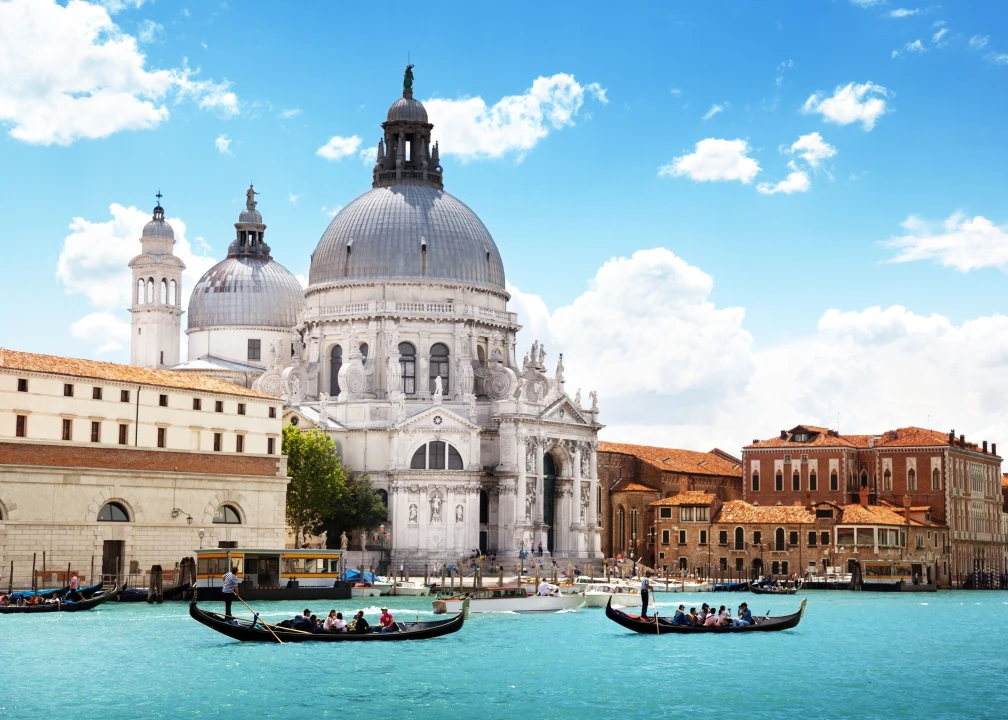Celebrated throughout the world for its singular beauty, Venice and its lagoon were added to the list of UNESCO World Heritage Sites in 1987.
Founded out of the necessity of fleeing the Barbarian Invasion in the 6th Century, Venice was already one of the most powerful cities in Europe around the year 1000. Beginning with the first settlements on the islands of Torcello, Iesolo and Malamocco, the city successively developed over 118 different islands, eventually becoming an important political, cultural and commercial center. Testaments to the power of the Marine Republic of Venice are still visible today, including its splendid piazzas, bridges, and palaces, inside of which are preserved the timeless artworks of Giorgione, Titian, Tintoretto, Veronese and many others.
The most famous place in Venice is, without a doubt, Piazza San Marco or St. Mark’s Square, the center from which rises the homonymous, five-domed St. Mark's Basilica. The bronze horses that dominate its main entrance were brought to Venice from Constantinople after the Fourth Crusade of 1204. Its interior is covered in mosaics (mostly in gold) that recount scenes from the Bible. The Basilica originally served as the chapel for the Doges of the Republic of Venice.
Next to the Basilica stands the Palazzo Ducale; these two buildings are joined by the monumental Porta della Carta. The Palazzo Ducale or Ducal Palace was, for several centuries, the most important government in Europe, administrated from inside the elaborate and lavish Higher Council Hall. The Campanile di San Marco (Bell Tower), realized in 1173, was reconstructed in front of the Palazzo Ducale after it collapsed in 1902. From the small loggia or gallery at the top of the bell tower (in the red marble of Verona) it is possible to admire reliefs depicting the ventures and undertakings of the “Republic of the Golden Lion.”
Not only, but the bridges of this “Most Serene Republic” (Serenissima) leave a grand impression, particularly the Ponte Rialto and the Ponte dei Sospiri or Bridge of Sighs - as do other sites like the Arsenale (the Navy Yard, in fact the largest in the world) from the 12th Century, the Basilicas of Santa Maria della Salute and of Santa Maria Gloriosa dei Frari, and the synagogues in the Jewish Ghetto. Important museum neighborhoods are Canareggio and the Giudecca, currently enjoying their own miniature renaissances, with numerous new artistic initiatives and innovations.
Venice is also celebrated for its historic cafes, especially the Florian; its exhibits, galleries and museums, such as Ca' Rezzonico; the Gallerie dell’Accademia and, of course, the Peggy Guggenheim Collection; and its world-famous festivals, i.e. for cinema and the Biennale for art, music and dance. The Teatro della Fenice is the monumental home to the city’s operatic music, and hosts the International Festival of Contemporary Music.
Situated on the extremity of a closed-off part of the sea, the lagoon is frequently subjected to the encumbrance of fluctuations in water levels – high water that periodically floods its piazzas, or even low waters that can obstruct navigation due to shallower canals.
Other highly sought-out touristic destinations in the lagoon are the islands of Murano and Burano, where visitors can see the typical artisan workshops for glass and lace, respectively. The Lido is a renowned seaside destination, and the seat of the celebrated Venice Film Festival, second best only to Venice's Carnival.
Venice is an open-air museum that seems to float on its lagoon. Visitors can walk its entirety if they want to, crossing its characteristic calle or vias, its campi and campitelli (piazzas and little piazzas, to be exact) and its magnificent bridges. Or they can watch the city go by from the comfort of a boat, choosing from private transport (the beloved gondolas), or public – the vaporetti – which boast the ideal vantage point (the Canal Grande) from which to observe all the fantastically beautiful scenery this unique place has to offer.




